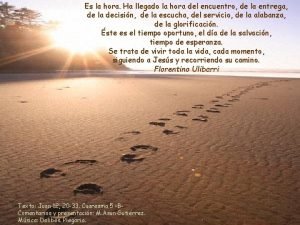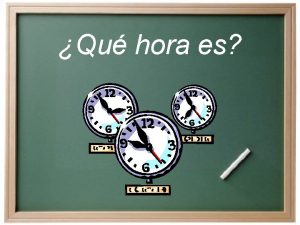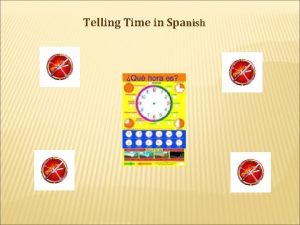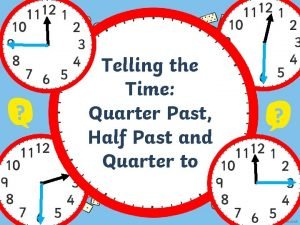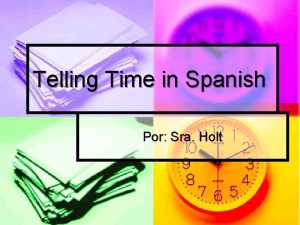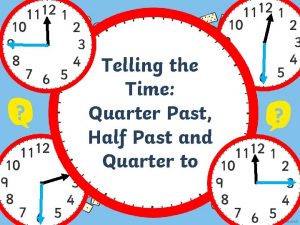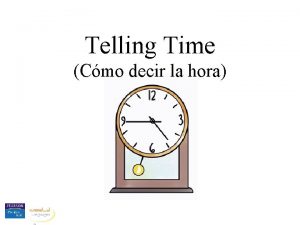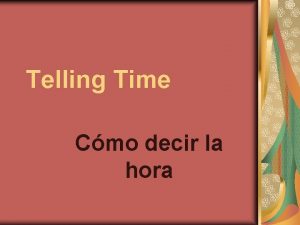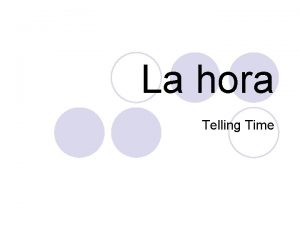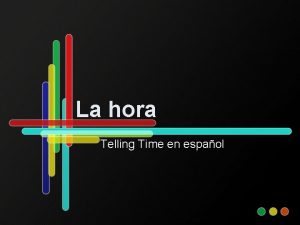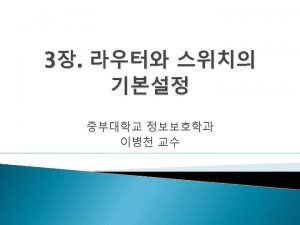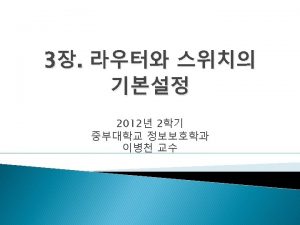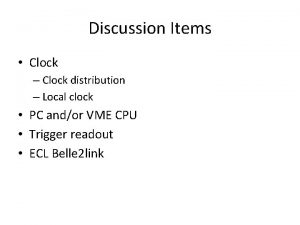La Hora Telling Time Clock Time To ask











- Slides: 11

La Hora Telling Time

Clock Time: � To ask the current time the question is: � ¿Qué hora es? � What time is it right now? � To ask the time of an event (i. e. a class): � ¿A qué hora es tu clase. ? � What time is your class?

The Current Time � To describe the current time in Spanish, the following word order is used: � If it’s 1: 00 � Es la una (y minutes) � If it’s 2: 00 or later: � Son las dos (tres, cuatro, cinco) (y minutes) � “Son” and “Es” come first, followed by the hour and minutes. � Es la una y quince. � Son las dos y trece. � Son las cinco y veinticinco. It’s 1: 15 It’s 2: 13 It’s 5: 25

� “Es” and “La” are only used with “una” � “Son” hour. and “Las” are used with every other � Hours are feminine in Spanish. The feminine definite articles are used. One o´clock is singular. The rest are plural.

� Midnight and Noon are exceptions to the “Es la/Son las” rule. � To say “it´s noon”: � Es el mediodía � To say it´s midnight � Es la medianoche. � If it´s minutes after either one, use “Son las doce y…”

� The equivalent of “past” is “y” � : 15 and : 30 are described as: � Cuarto (quarter) � Media (half) � Son las dos y media � Son las ocho y cuarto It’s 2: 30 It’s 8: 15

� When describing minutes after half past ( : 35 - : 59) replace “y” with “menos” and give the time ahead one hour. This is similar to English using “twenty five to, ” “quarter to” or “ten to” � Son las seis menos cuarto � It’s quarter to six (5: 45) � Son las tres menos diez � It’s ten to three (2: 50)

� Spanish doesn’t really use “AM” and “PM” the way English does. Spanish speakers indicate “AM” and “PM” by using the phrase “in the morning/afternoon/evening” � De la mañana. (also: De la madrugada) � De la tarde. � De la noche � Son las cuatro de la mañana. � Son las seis de la tarde. � Son las once menos diez de la noche.

� When describing a non-specific time of day (i. e. in the morning, afternoon) Use: � Por la mañana � Por la tarde � Por la noche � ¿Estudias por la mañana, ? � No, Estudio por la tarde. Trabajo por la mañana. � “De” is used after a clock time. � “Por” is used when there is no clock time � “En” is never, ever used.

� When describing the time of an event (not the current time) “A las + hora” is used instead of “Son las +hora”. � ¿A qué hora…? � ¿Qué hora es? (At) what time is…? What time is it (now)? � “Son It’s 5 It’s at 5 las 5” � “Es a las 5” � ¿A qué hora es tu examen? � Mi examen es a las cinco de la tarde. � What � My time is your exam? exam is at five PM.

 Hora ha
Hora ha Un algodonero recoge 30 kg cada hora y demora media hora
Un algodonero recoge 30 kg cada hora y demora media hora Doce decimos de hora menos dos decimos de hora
Doce decimos de hora menos dos decimos de hora My favourite... questions
My favourite... questions Pendleton rules of feedback
Pendleton rules of feedback Fast clock to slow clock synchronization
Fast clock to slow clock synchronization One minute
One minute What time in spanish
What time in spanish Telling time and date
Telling time and date Whats quarter past
Whats quarter past Telling time in spanish chart
Telling time in spanish chart Time in quarters
Time in quarters
